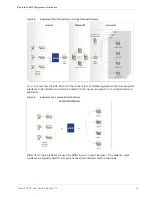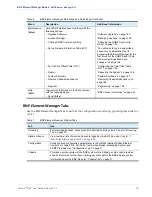
Selenio
TM
BNP User Guide, Release 3.7.1
16
Overview
- BNP Applications
Messaging System Applications
BNP support for messaging system applications is described in the following topics:
•
Digital EAS and Operator / Advanced Messaging
.
•
.
Digital EAS and Operator / Advanced Messaging
Leveraging its existing high-density video processing technology, the BNP’s digital Messaging System
capability allows operators to program both digital SCTE 18 Emergency Alert System (EAS) alerts and
operator-generated messages. The Advanced Messaging option allows importing graphics and text
files into the operator crawl message. EAS and Operator / Advanced Messaging alerts are delivered
universally throughout the network, overcoming existing challenges that cable operators face in
supporting analog and digital subscribers with an increasing range of decoding technologies.
The BNP’s Messaging System support can be applied selectively to any MPEG-2 program being
processed. EAS and operator-generated messages are digitally rendered and overlaid directly onto a
program, delivered directly to any digital subscriber set-top box or to analog decoders, and presented
as an overlay alert crawl to viewers. The BNP also supports operator-configurable audio override or
audio stream insertion to complement the text crawl message generated by industry-leading EAS
management vendors for a completely customizable deployment.
A BNP in an SCTE 18 digital EAS application is shown in
.
Figure 5.
BNP in SCTE 18 Digital EAS Application
RGB
Broadcast Network Processor
Digital Encoder
QAM Modulator
Baseband
Audio
Baseband
Video
Digital
Video Services
SCTE-18
Messaging
(contains Text Crawl)
Digital EAS
Audio &
Video
Digital Video
Services with
EAS Text Crawl
and
Audio Override
NTSC
Modulated
Channels
GigE
10BT
GigE
GigE
EAS
ENDEC
(SCTE-18
Compliant)
Digital Decoder and
Modulator
GigE
GigE
QAM
Modulated
Channels
B N P
Graphic Overlay Insertion
In addition to EAS and operator messaging, the BNP Messaging System Logo Overlay option supports
insertion of graphic overlays into any MPEG-2 program being processed. Graphic overlays are based on
importing static graphic Portable Network Graphics (PNG) files. Importing text files is also supported,
meaning that customers can create a library of graphic and text files to routinely use (see workflow
example below). You can preview the imported PNG files before starting the overlay insertion.
The location of the insertion is configurable with positioning anywhere on the display screen defined
by (x,y) screen coordinates based on pixels relating to program resolution (e.g., SD and HD). Logo
overlay files can be created with PNG alpha channels to control transparency effects supported by the
BNP during the insertion of the overlay. Additionally, background transparency support is available for
non-ascii text overlays in order to support foreign markets.
















































